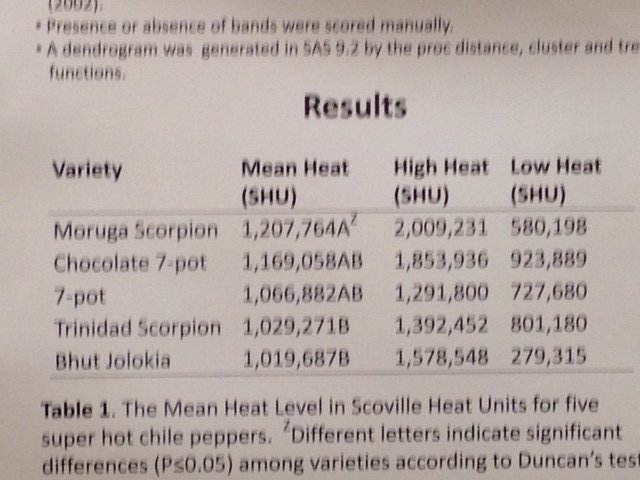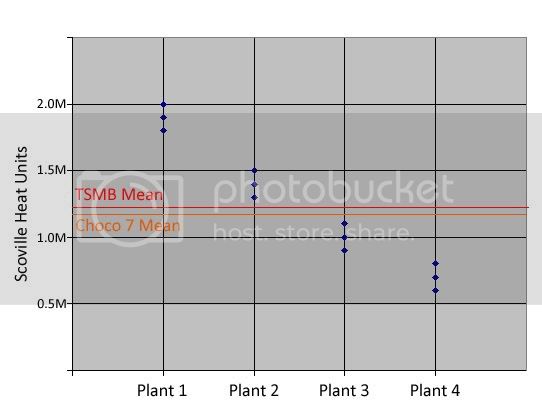So as you all should know, today there has been a lot of talk about the new hottest pepper in the world. The most prestigious hot pepper institute in the world, the New Mexico State University Chili Pepper Institute, had a sample of the Trinidad Scorpion Morouga Blend test at over 2M SHU. So what does that mean? What should you expect? Is it the hottest pepper in the world?
Well before we break this down, let's take a little peek at the numbers. Here they are:

We need to know how they got these numbers and what they mean before we analyze them. Here is how the experiment was carried out:
Four plants from each of the five super hot strains were selected at random. 25 pods from each of these plants were picked, dried, and ground. This leaves four samples of each strain, each containing the dried powder from 25 peppers. Each sample was divided up and analyzed at three different labs. One sample of the Trinidad Scorpion Morouga Blend tested at around 2 million SHU at one of the labs. To better understand what's happening here, I created a sample graph showing the results of the experiment. I estimated the data points based on the given max, min, and mean values, as well as past known results. This graph is only for the TSMB plants.

I want you to note a few things from this graph:
1. Each plant has three data points, one from each lab (estimated). They are 100 SHU apart for a total spread of 200 SHU.
2. This graph goes from 0-2M SHU. Note how incredibly far apart all of these data values are, and how little 100,000 SHU looks like on the graph! This data is ALL OVER THE PLACE.
3. There are two means on the graph. The top (red) one is for the TSMB mean, and the bottom is the Chocolate 7 mean. Note how close they are together in comparison to the rest of the data points.
Based on these data points we can come to ONLY ONE conclusion, and a weak one at that:
The TSMB has produced the hottest chili sample ever tested by HPLC.
That's it. Nothing more. All of the other results are inconclusive, but they are fun to look at. The CPI took four samples, and used three labs to clarify the SHU reading of each one. This reduces the amount of error that they can have by using four standardized SHU measurements, but they still failed to use enough samples to make their results look worthwhile. Simply put, they accounted for the error of the HPLC measurements, but did NOT account for the large standard deviation of pepper heat between plants/pods.
What happens to our means if we add a fifth sample? All we need to drop the mean of the TSMB measurement down below the Chocolate 7 mean is one perfectly reasonable new data point. In fact, if a new sample of TSMB came in at 900,000 SHU (average from each lab) and all of the other means stayed the same, the Chocolate 7 would have the new highest mean.
With only four samples, who's to say that if they tested 10 more plants that the Chocolate 7 wouldn't have tested 2.1M in one sample? Frankly, with a standard deviation this high we can't say anything about which one is hotter and which one can create hotter pods. However, this test study does give us a good idea of how hot these pods are. The data isn't useless. I would say that we can say with relative certainty that the Bhut Jolokia, 7 pot, and possibly even Trinidad Scorpion are not the hottest pepper in the world. I wouldn't say that we can be 100% certain, but we can at least have a decent amount of confidence. There's always the possibility that the lowest sample of the TSMB was a fluke and it in fact averages much higher and CAN be called the hottest in the world. Of course we will have to wait for future testing to see that.
For future tests, I would recommend a data set containing samples from at LEAST a dozen plants, with tests done on the Chocolate 7, TSMB, Trinidad Scorpion, and the Douglah. There should also be testing done confirming that the Brain Strain and TSMB are the same strain, otherwise the Brain Strain should be tested as well. This will give us a MUCH better picture of which pepper can in fact be called the hottest in the world. Once we have tested enough samples we can form a bell curve for each of the hottest strains and more accurately describe the range and average heat a chili plant will produce under a given set of conditions. It's a nice thought, but a lot of work.
Hopefully this helps you guys understand this study and helps you in finding the hottest chilies for yourselves. Quite frankly there are a lot at the top and we can't call any one pod the hottest at the moment. The only way to see what you like for heat and flavor is to try your own.
Well before we break this down, let's take a little peek at the numbers. Here they are:

We need to know how they got these numbers and what they mean before we analyze them. Here is how the experiment was carried out:
Four plants from each of the five super hot strains were selected at random. 25 pods from each of these plants were picked, dried, and ground. This leaves four samples of each strain, each containing the dried powder from 25 peppers. Each sample was divided up and analyzed at three different labs. One sample of the Trinidad Scorpion Morouga Blend tested at around 2 million SHU at one of the labs. To better understand what's happening here, I created a sample graph showing the results of the experiment. I estimated the data points based on the given max, min, and mean values, as well as past known results. This graph is only for the TSMB plants.

I want you to note a few things from this graph:
1. Each plant has three data points, one from each lab (estimated). They are 100 SHU apart for a total spread of 200 SHU.
2. This graph goes from 0-2M SHU. Note how incredibly far apart all of these data values are, and how little 100,000 SHU looks like on the graph! This data is ALL OVER THE PLACE.
3. There are two means on the graph. The top (red) one is for the TSMB mean, and the bottom is the Chocolate 7 mean. Note how close they are together in comparison to the rest of the data points.
Based on these data points we can come to ONLY ONE conclusion, and a weak one at that:
The TSMB has produced the hottest chili sample ever tested by HPLC.
That's it. Nothing more. All of the other results are inconclusive, but they are fun to look at. The CPI took four samples, and used three labs to clarify the SHU reading of each one. This reduces the amount of error that they can have by using four standardized SHU measurements, but they still failed to use enough samples to make their results look worthwhile. Simply put, they accounted for the error of the HPLC measurements, but did NOT account for the large standard deviation of pepper heat between plants/pods.
What happens to our means if we add a fifth sample? All we need to drop the mean of the TSMB measurement down below the Chocolate 7 mean is one perfectly reasonable new data point. In fact, if a new sample of TSMB came in at 900,000 SHU (average from each lab) and all of the other means stayed the same, the Chocolate 7 would have the new highest mean.
With only four samples, who's to say that if they tested 10 more plants that the Chocolate 7 wouldn't have tested 2.1M in one sample? Frankly, with a standard deviation this high we can't say anything about which one is hotter and which one can create hotter pods. However, this test study does give us a good idea of how hot these pods are. The data isn't useless. I would say that we can say with relative certainty that the Bhut Jolokia, 7 pot, and possibly even Trinidad Scorpion are not the hottest pepper in the world. I wouldn't say that we can be 100% certain, but we can at least have a decent amount of confidence. There's always the possibility that the lowest sample of the TSMB was a fluke and it in fact averages much higher and CAN be called the hottest in the world. Of course we will have to wait for future testing to see that.
For future tests, I would recommend a data set containing samples from at LEAST a dozen plants, with tests done on the Chocolate 7, TSMB, Trinidad Scorpion, and the Douglah. There should also be testing done confirming that the Brain Strain and TSMB are the same strain, otherwise the Brain Strain should be tested as well. This will give us a MUCH better picture of which pepper can in fact be called the hottest in the world. Once we have tested enough samples we can form a bell curve for each of the hottest strains and more accurately describe the range and average heat a chili plant will produce under a given set of conditions. It's a nice thought, but a lot of work.
Hopefully this helps you guys understand this study and helps you in finding the hottest chilies for yourselves. Quite frankly there are a lot at the top and we can't call any one pod the hottest at the moment. The only way to see what you like for heat and flavor is to try your own.

 oh well, maybe at the end of this summer I can go up there with some pods and ask my bio and chem professors if I could give it a shot.. if they are setup for it, if at all possible.. I was already planning on giving my bio professor who is a botanist one of the chili plants if he wanted for he big greenhouse
oh well, maybe at the end of this summer I can go up there with some pods and ask my bio and chem professors if I could give it a shot.. if they are setup for it, if at all possible.. I was already planning on giving my bio professor who is a botanist one of the chili plants if he wanted for he big greenhouse